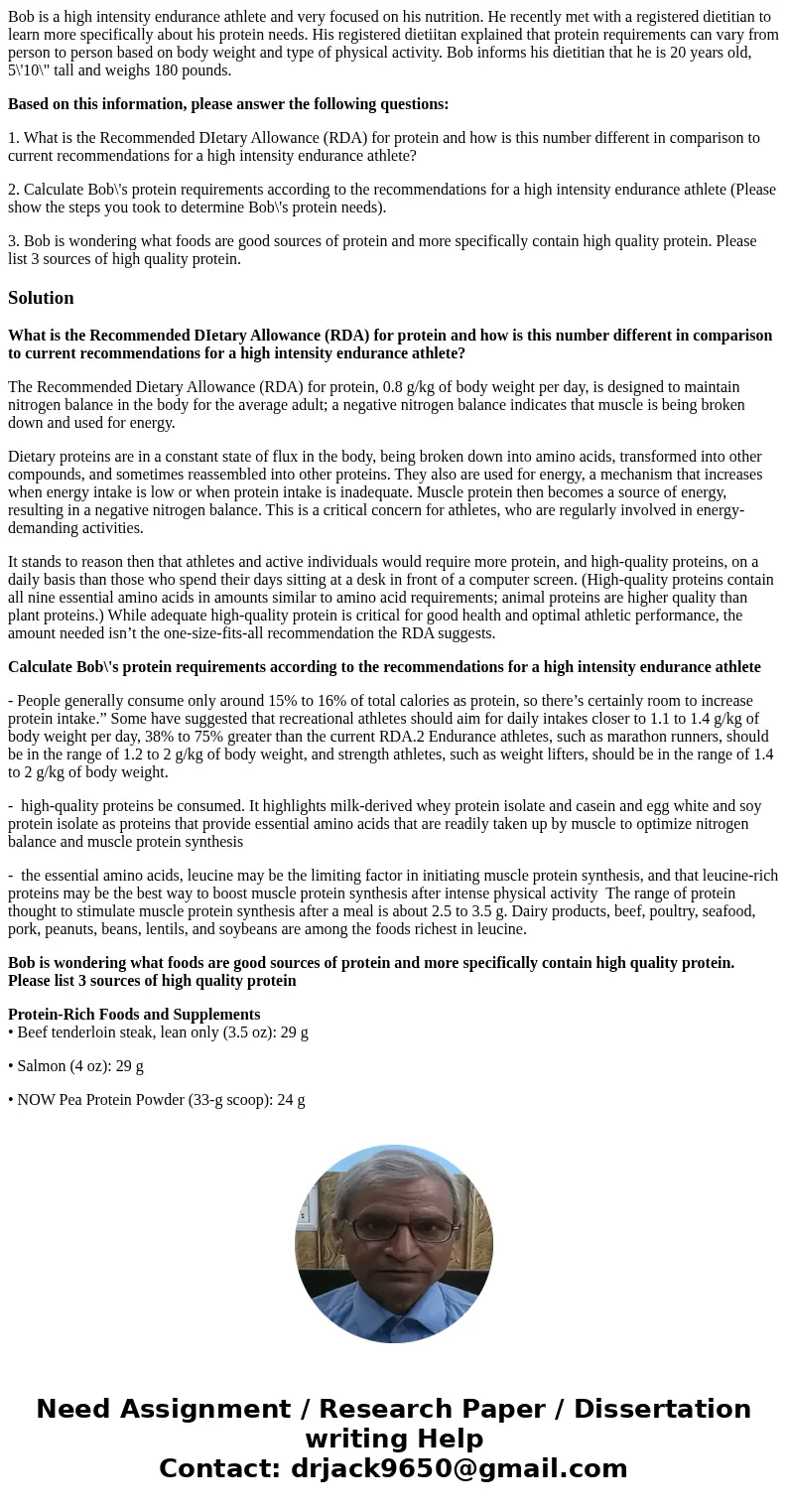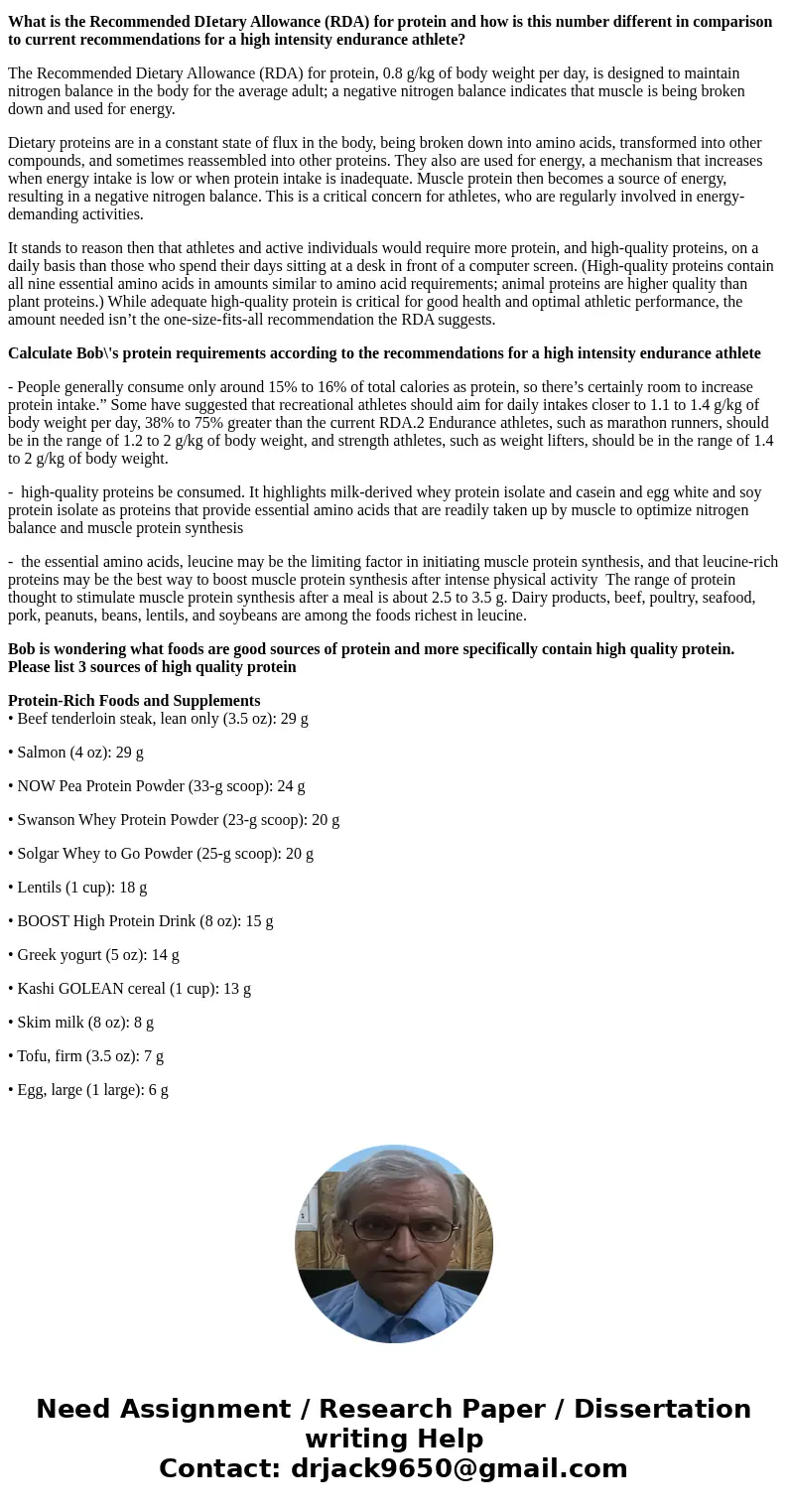Bob is a high intensity endurance athlete and very focused o
Bob is a high intensity endurance athlete and very focused on his nutrition. He recently met with a registered dietitian to learn more specifically about his protein needs. His registered dietiitan explained that protein requirements can vary from person to person based on body weight and type of physical activity. Bob informs his dietitian that he is 20 years old, 5\'10\" tall and weighs 180 pounds.
Based on this information, please answer the following questions:
1. What is the Recommended DIetary Allowance (RDA) for protein and how is this number different in comparison to current recommendations for a high intensity endurance athlete?
2. Calculate Bob\'s protein requirements according to the recommendations for a high intensity endurance athlete (Please show the steps you took to determine Bob\'s protein needs).
3. Bob is wondering what foods are good sources of protein and more specifically contain high quality protein. Please list 3 sources of high quality protein.
Solution
What is the Recommended DIetary Allowance (RDA) for protein and how is this number different in comparison to current recommendations for a high intensity endurance athlete?
The Recommended Dietary Allowance (RDA) for protein, 0.8 g/kg of body weight per day, is designed to maintain nitrogen balance in the body for the average adult; a negative nitrogen balance indicates that muscle is being broken down and used for energy.
Dietary proteins are in a constant state of flux in the body, being broken down into amino acids, transformed into other compounds, and sometimes reassembled into other proteins. They also are used for energy, a mechanism that increases when energy intake is low or when protein intake is inadequate. Muscle protein then becomes a source of energy, resulting in a negative nitrogen balance. This is a critical concern for athletes, who are regularly involved in energy-demanding activities.
It stands to reason then that athletes and active individuals would require more protein, and high-quality proteins, on a daily basis than those who spend their days sitting at a desk in front of a computer screen. (High-quality proteins contain all nine essential amino acids in amounts similar to amino acid requirements; animal proteins are higher quality than plant proteins.) While adequate high-quality protein is critical for good health and optimal athletic performance, the amount needed isn’t the one-size-fits-all recommendation the RDA suggests.
Calculate Bob\'s protein requirements according to the recommendations for a high intensity endurance athlete
- People generally consume only around 15% to 16% of total calories as protein, so there’s certainly room to increase protein intake.” Some have suggested that recreational athletes should aim for daily intakes closer to 1.1 to 1.4 g/kg of body weight per day, 38% to 75% greater than the current RDA.2 Endurance athletes, such as marathon runners, should be in the range of 1.2 to 2 g/kg of body weight, and strength athletes, such as weight lifters, should be in the range of 1.4 to 2 g/kg of body weight.
- high-quality proteins be consumed. It highlights milk-derived whey protein isolate and casein and egg white and soy protein isolate as proteins that provide essential amino acids that are readily taken up by muscle to optimize nitrogen balance and muscle protein synthesis
- the essential amino acids, leucine may be the limiting factor in initiating muscle protein synthesis, and that leucine-rich proteins may be the best way to boost muscle protein synthesis after intense physical activity The range of protein thought to stimulate muscle protein synthesis after a meal is about 2.5 to 3.5 g. Dairy products, beef, poultry, seafood, pork, peanuts, beans, lentils, and soybeans are among the foods richest in leucine.
Bob is wondering what foods are good sources of protein and more specifically contain high quality protein. Please list 3 sources of high quality protein
Protein-Rich Foods and Supplements
• Beef tenderloin steak, lean only (3.5 oz): 29 g
• Salmon (4 oz): 29 g
• NOW Pea Protein Powder (33-g scoop): 24 g
• Swanson Whey Protein Powder (23-g scoop): 20 g
• Solgar Whey to Go Powder (25-g scoop): 20 g
• Lentils (1 cup): 18 g
• BOOST High Protein Drink (8 oz): 15 g
• Greek yogurt (5 oz): 14 g
• Kashi GOLEAN cereal (1 cup): 13 g
• Skim milk (8 oz): 8 g
• Tofu, firm (3.5 oz): 7 g
• Egg, large (1 large): 6 g


 Homework Sourse
Homework Sourse